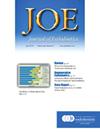Continuous Chelation Reduces Instrumentation Time and Straightening of Double-curved Simulated Root Canals in Bovine Dentin
IF 3.5
2区 医学
Q1 DENTISTRY, ORAL SURGERY & MEDICINE
引用次数: 0
Abstract
Introduction
Adding a compatible chelator to the sodium hypochlorite (NaOCl) solution applied during instrumentation may affect shaping efficacy and canal transportation. This was studied in simulated double-curved root canals.
Methods
High-precision computer numerical control milling was used to recreate standardized S-shaped canals from a resin training block in longitudinally sectioned bovine incisor roots. These simulated root canals were instrumented chemo-mechanically at 37°C using a single-length rotary file system (ProTaper Gold). An etidronate powder (Dual Rinse HEDP) was dissolved (0.9 g per 10 mL) in a 1% NaOCl solution in the test group (n = 15), while the plain NaOCl solution was applied in the control group. Instrumentation was performed by one operator blinded to the irrigating solution. Instrumentation time was measured using a stop watch. Pre- and postoperative images were obtained by a second (blinded) investigator using a digital microscope, and super-imposed to assess canal straightening by totalizing transportation from 8 predefined locations. Data were compared between groups using Student's t-test, P < .05.
Results
Adding the chelator, total instrumentation time was reduced to 75 ± 12 s as compared to 86 ± 14 s with plain NaOCl (P < .05). This time difference was related to the first rotary instrument in the system (S1). Canal straightening was also reduced significantly with the chelator compared to the plain 1% NaOCl solution (P < .05), while transportation at working length was similar between groups.
Conclusion
Under current conditions, continuous chelation expedited canal instrumentation and maintained simulated canal curvatures.
连续螯合减少了牛牙本质双弯曲模拟根管的预备时间和矫直。
简介:在器械过程中,在次氯酸钠(NaOCl)溶液中添加相容的螯合剂可能会影响整形效果和管道运输。这是在模拟双弯曲根管中进行的研究。方法:采用高精度计算机数控铣削方法,用树脂训练块在牛切牙根纵切面上重建标准化的s形管。这些模拟根管使用单长度旋转文件系统(ProTaper Gold)在37°C下进行化学机械固定。试验组(n = 15)将依地膦酸酯粉末(Dual Rinse HEDP)(每10 mL 0.9 g)溶解于1% NaOCl溶液中,对照组(n = 15)使用普通NaOCl溶液。仪器由一名不知道冲洗溶液的操作人员进行。仪器时间是用秒表测量的。术前和术后图像由第二名(盲法)研究者使用数码显微镜获得,并通过汇总8个预定位置的运输来叠加评估根管矫直程度。结果:与普通NaOCl组相比,添加螯合剂后,总仪器检测时间缩短至75±12 s (P < 0.05)。这个时间差与系统中的第一个旋转仪器(S1)有关。与普通1% NaOCl溶液相比,螯合剂也显著减少了根管矫直(P < 0.05),而两组之间的工作长度运输相似。结论:在目前的条件下,持续螯合加速了根管的预备,维持了模拟的根管曲率。
本文章由计算机程序翻译,如有差异,请以英文原文为准。
求助全文
约1分钟内获得全文
求助全文
来源期刊

Journal of endodontics
医学-牙科与口腔外科
CiteScore
8.80
自引率
9.50%
发文量
224
审稿时长
42 days
期刊介绍:
The Journal of Endodontics, the official journal of the American Association of Endodontists, publishes scientific articles, case reports and comparison studies evaluating materials and methods of pulp conservation and endodontic treatment. Endodontists and general dentists can learn about new concepts in root canal treatment and the latest advances in techniques and instrumentation in the one journal that helps them keep pace with rapid changes in this field.
 求助内容:
求助内容: 应助结果提醒方式:
应助结果提醒方式:


